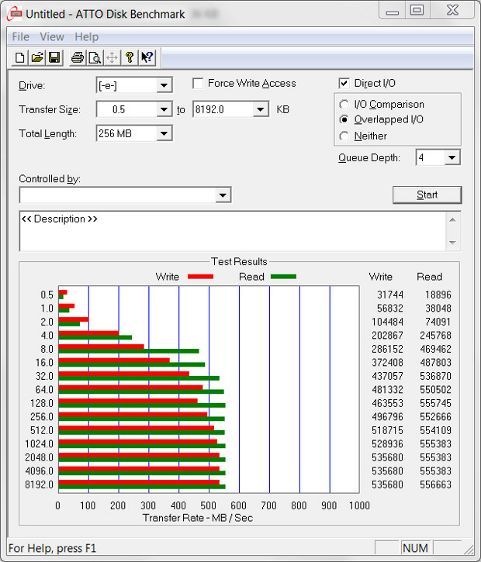ATTO Disk Benchmark has been around as long or longer than most any other storage performance benchmark. ATTO uses RAW (or compressible) data, and for today’s benchmarking test we will use a set length of 256MB. We will be testing both the read and write performance of various transfer sizes ranging from 0.5KB to 8192KB. This is the testing method preferred by most manufacturers, as it tests with RAW (compressible) data, rather than random (including incompressible) data. Although random and incompressible data may be a more realistic usage scenario, testing with it will give lower performance results.
Once we hit transfer sizes of 512KB or larger, the Force Series LS is a strong performer. The top read speed of 556,663 (556.6 MB/s) bests many SATA III SSDs on the market. It beats Corsair’s Neutron and Neutron GTX, and rubs shoulders with the SandForce-based Force GS. At 535.6 MB/s the write speeds are even stronger, and best all three of the other Corsair SSDs we referred to.
CRYSTAL DISK BENCHMARK VER. 3.0 X64
Crystal Disk Benchmark is used to test read and write performance through sampling of raw (0/1 fill / compressible) data, or random data that is mostly incompressible. The left screenshot displays the compressible (0 fill) results, and the right screenshot displays incompressible (random data) results.
The “0 fill” results are strong, and note the solid comparative write speeds in all four categories. The random sequential read speeds show almost no drop — 515.4 MB/s compared to 521.9 MB/s. Again, the comparative write speeds are strong in all four areas.
AS SSD was until recently the only benchmark created specifically for SSD testing, and it uses incompressible data. For the most part, AS SSD shows us “worst case scenario” SSD transfer speeds because of its use of incompressible data. Enthusiasts often prefer AS SSD for this reason, as they seek to see minimum performance as well as maximum performance. Transfer speeds in MB/s are shown in the left screenshot, IOPs in the right screenshot.
The sequential read speeds are on par with other Corsair SSDs we have recently reviewed, such as the Neutron / Neutron GTX and the Force GS 240GB, but the write speeds are better than the Neutron GTX and the Force GS. The 4K-64 thrd read speed is on the light side, yet the write speed bests the Force GS.
 The SSD Review The Worlds Dedicated SSD Education and Review Resource |
The SSD Review The Worlds Dedicated SSD Education and Review Resource | 


On page 3 of the review your yellow heading for “Crystal Disk Info Ver 3.9.3” appears to need correcting to keep in line with the version used in the test: 5.6.2.
It’s just amazing, the time we live in. SATA III just came out a couple of years back and some of us are disappointed with the 6Gbps speed, which constituted “the latest and the greatest” what feels like just yesterday.
I am very much part of that group. When I heard about the newly refreshed iMacs, I was disappointed that Thunderbolt 2 wasn’t part of the equation, as I am very much looking forward to a 4K monitor as soon as they’re less cost-prohibitive, but when I read down the press release and found out the new specs included a new PCIe SSD, I immediately sold off my now former souped-up Mac mini, and placed my order for one of those babies.